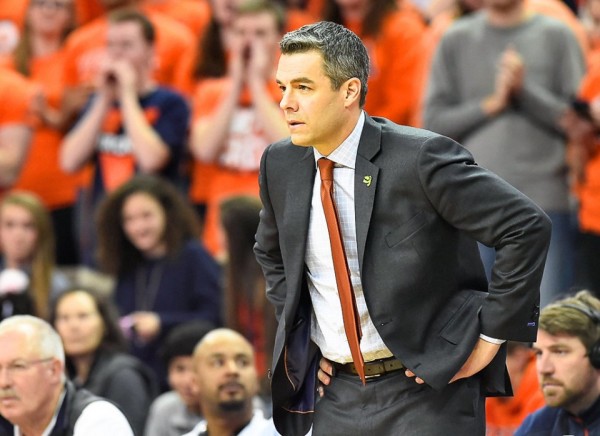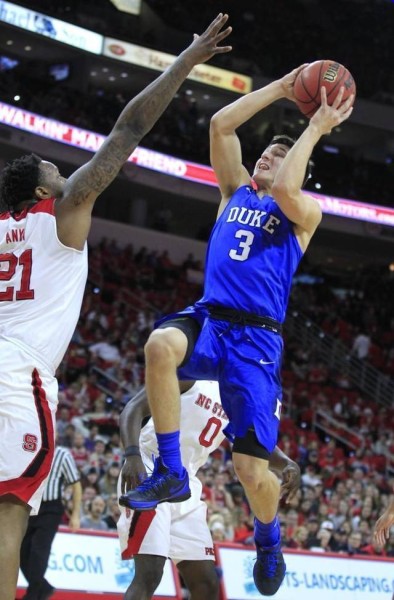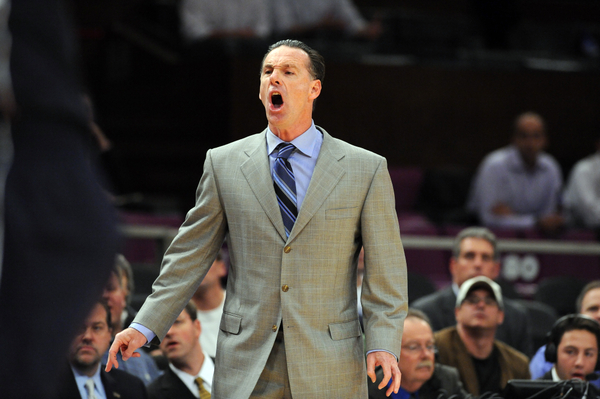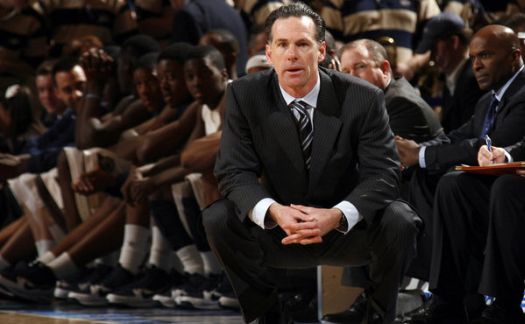ACC Weekend Review: 01.25.16 Edition
Posted by Brad Jenkins (@bradjenk) on January 25th, 2016Once again, it wasn’t exactly a weekend of mega-matchups in the ACC. Going into Saturday’s action, the league had seven teams rated in KenPom’s top 38, yet none of them faced each other over the weekend. Some of the games were affected by winter storm Jonas, which caused the rescheduling of two games. On Sunday afternoon, North Carolina continued its undefeated ways in the ACC by holding off a feisty Virginia Tech squad in a game that was moved from Sunday night due to travel concerns in Blacksburg. Syracuse probably faced the toughest travel adversity, finally arriving in Charlottesville less than seven hours before Sunday night’s tipoff. In a game that had been originally scheduled for Saturday night, Virginia pulled away in the closing seconds to hang on against an Orange team that is suddenly playing well. Saturday, three road teams were successful in tight contests; Duke snapped its three game losing streak by beating N.C. State in Raleigh; Louisville gave Georgia Tech another tough home loss; and Pittsburgh rallied from a big halftime deficit to overtake Florida State. In other Saturday action, Miami broke open a tight game late to defeat Wake Forest, and Notre Dame blasted Boston College even though the Irish lost point guard Demetrius Jackson to injury just minutes into the game. Here are some of the highlights from the weekend in the ACC.

Tony Bennett and Virginia earned a hard fought win over Syracuse on Sunday night.
(Stephen D. Cannerelli/syracuse.com)
- Best Win: Since we didn’t have any blockbuster matchups or big upsets this weekend, we will declare Virginia‘s home 73-65 victory over Syracuse as the best ACC win of the weekend. The Cavaliers came into the contest with a disappointing 3-3 ACC record and were facing one of the hottest teams in the league. After dropping their first four league games, the Orange had ripped off three straight wins, including two on the road. The Syracuse surge looks to be directly related to the return of Jim Boeheim, who had to serve a NCAA mandated nine-game suspension that included the school’s first three ACC games. The Cavaliers led most of the way but couldn’t shake the Orange, who made 13 three-pointers, until the end. Tony Bennett‘s big three led the way as usual; Malcolm Brogdon scored 21 points; Anthony Gill had 16 points and eight rebounds; and London Perrantes finished with 16 points and seven assists.
- Worst Loss: After 20 minutes of play, Florida State was looking good against Pittsburgh. The Seminoles were at home, leading by 10, and playing a team coming off a confidence killing home loss to NC State earlier in the week. But two weaknesses from the past came back to haunt Leonard Hamilton‘s team, who let the Panthers come back to take an important 74-72 win in a matchup of NCAA Tournament hopefuls. Somehow, Florida State managed to lose despite outshooting Pitt from the field by a wide margin (53.7 percent to 39.3 percent). Pitt won as a result of having more chances to score, thanks to a +6 edge in both offensive rebounds and turnovers. Those two areas have long been an issue for the Seminoles during Hamilton’s tenure, but hadn’t this year until conference play began. Currently, Florida State ranks 13th in the league in turnover margin and last in defensive rebounding percentage in ACC games.

Grayson Allen had a strong all-around game to help Duke end its losing streak.
(Ethan Hyman/The News & Observer)
- Most Outstanding Player: Few Duke teams have needed a regular season win as desperately as this team needed this win on Saturday against rival N.C. State. The Blue Devils had lost three consecutive ACC games coming into the day, all of which had been winnable in the final minute of play. Grayson Allen made sure the Blue Devils’ losing streak came to an end with an excellent all-around performance. The sophomore guard led all scorers with 28 points, shooting 11-17 from the floor and 5-5 from the line. Allen also dished out seven assists and helped out on the glass, finishing with seven rebounds – six of them on the defensive end. Allen is making a strong case for first team All-ACC honors, as he currently ranks second in the ACC in scoring. He’s also fifth in both field goal percentage and assists in ACC games.
- Unsung Heroes: The most obvious choice here is sophomore big man Anas Mahmoud of Louiville. The native of Cairo, Egypt more than doubled his previous career high, finishing with 15 points in the Cardinals’ road win over Georgia Tech. Mahmoud has been gaining more confidence and playing time from Rick Pitino lately, averaging close to eight points and six boards in his last four outings. Pitt’s Jamie Dixon was glad to see Sterling Smith snap out of his slump, as the graduate transfer tied his season-high with 16 points, including four three-pointers. Smith was much more aggressive than he was in his three prior contests, when he only attempted a total of four shots in 56 minutes of play. Finally, Miami’s Ja’Quan Newton deserves recognition. Newton helped break open a tight game with Wake Forest by scoring 13 of his 18 points in the second half. The aggressive sophomore has been solid off the bench all year for the Hurricanes – he’s second on the team in both scoring and assists, and leads the team in free throw attempts despite playing less than 22 minutes per game.
- Most Efficient Offense/Least Efficient Defense: At half-time of Saturday’s game in Raleigh, Duke trailed by seven, which was due in great part to a soft Blue Devil zone defense that allowed N.C. State to shoot 56.7 percent from the field. But according to Mike Krzyzewski after the game, despite the deficit and defensive struggles, the zone at least allowed his thin Duke team to be much fresher for the second half than they had been in their previous three losses. The strategy worked (at least for one game) as Duke scored 52 points on 31 second half possessions. For the game, the Blue Devils averaged 1.33 points per possession. Duke shot the ball well in all areas: 65 percent on two-pointers, 40 percent on threes, and 78 percent from the foul line.
- Most Efficient Defense/Least Efficient Offense: We don’t expect to see Notre Dame’s defense win this honor very often, but when the opponent is Boston College, even the Irish’s normally generous defense can look good. The Eagles managed only 0.74 points per possession on Saturday in South Bend and rank 338th in the country in KenPom’s adjusted offensive efficiency ratings. You can safely expect to see them in this category a few more times this season. The biggest issue for BC in this game was two-point shooting, as the Eagles made just eight of their 38 two-point attempts.











































